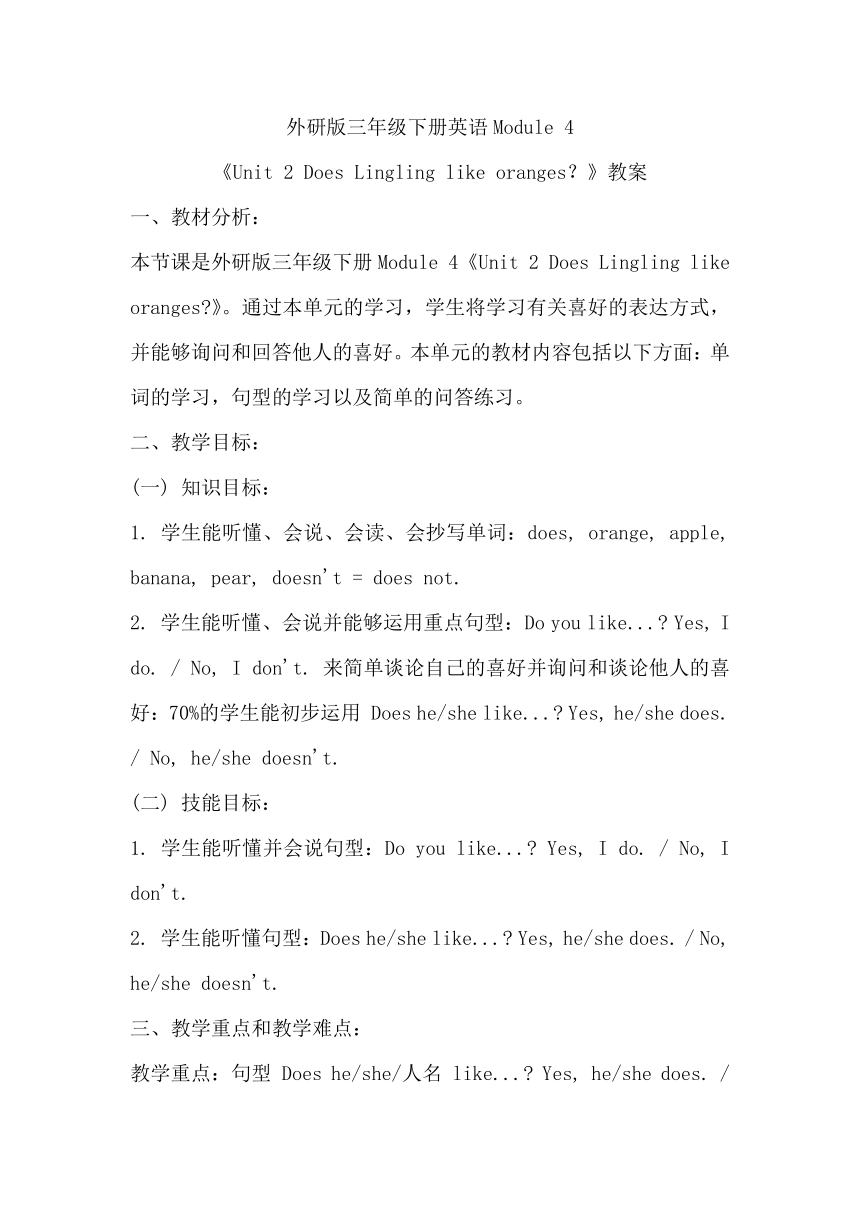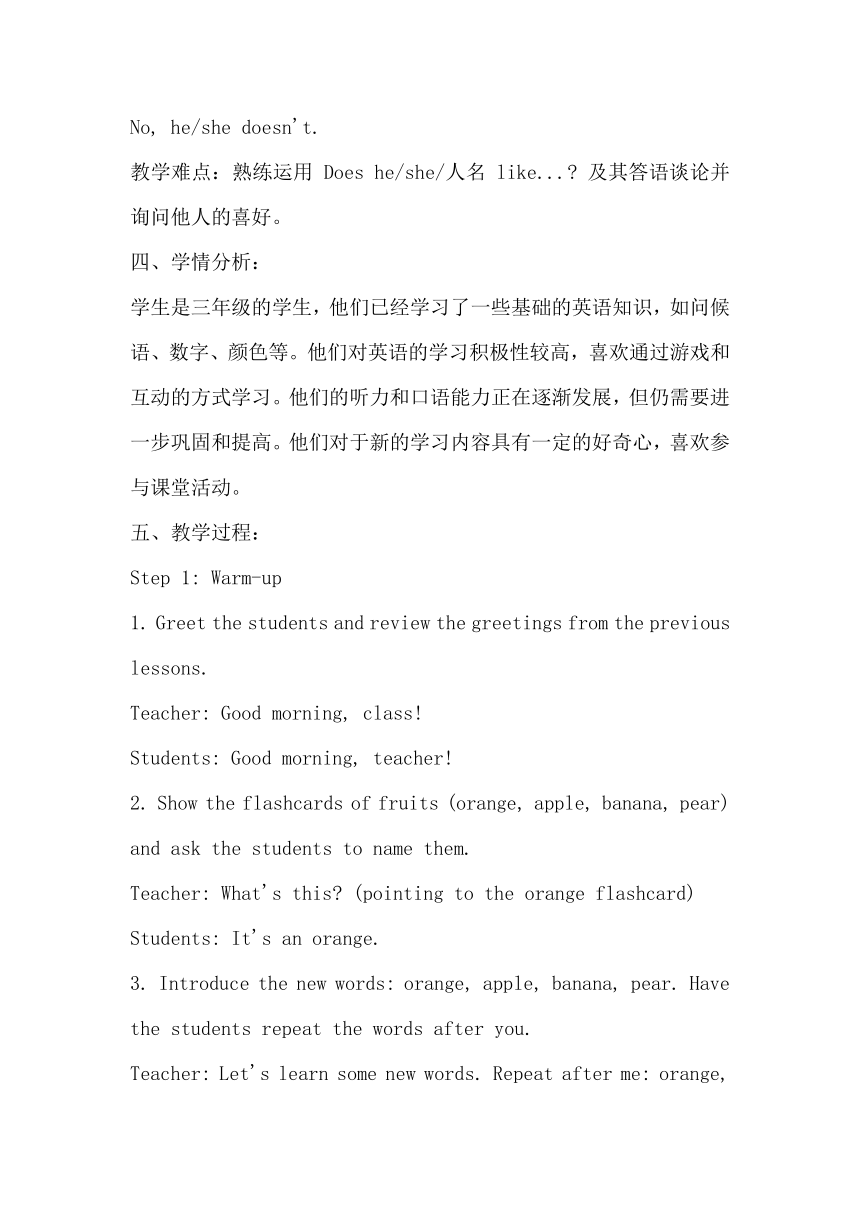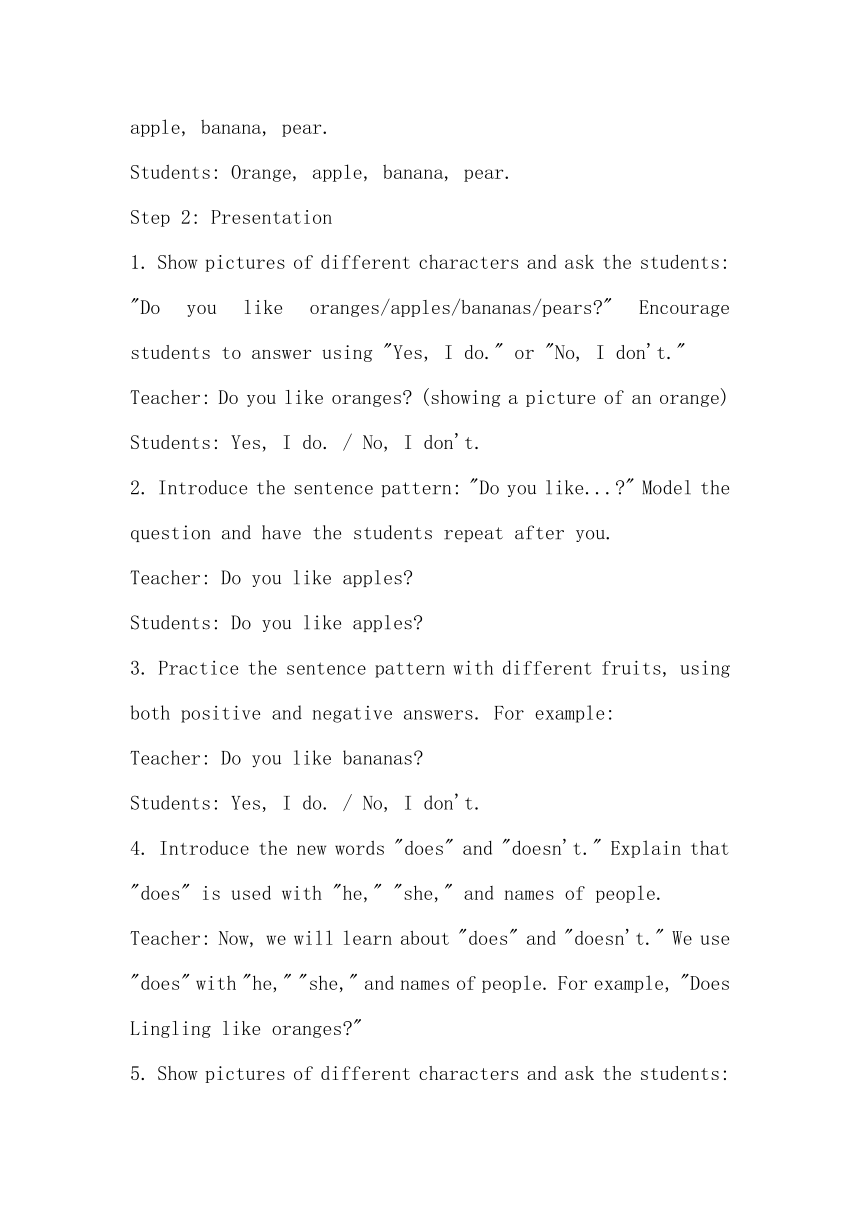Module 4 Unit 2 Does Lingling like oranges? 教案(含反思)
文档属性
| 名称 | Module 4 Unit 2 Does Lingling like oranges? 教案(含反思) |  | |
| 格式 | docx | ||
| 文件大小 | 18.8KB | ||
| 资源类型 | 教案 | ||
| 版本资源 | 外研版(三年级起点) | ||
| 科目 | 英语 | ||
| 更新时间 | 2024-01-29 19:28:18 | ||
图片预览



文档简介
外研版三年级下册英语Module 4
《Unit 2 Does Lingling like oranges?》教案
一、教材分析:
本节课是外研版三年级下册Module 4《Unit 2 Does Lingling like oranges 》。通过本单元的学习,学生将学习有关喜好的表达方式,并能够询问和回答他人的喜好。本单元的教材内容包括以下方面:单词的学习,句型的学习以及简单的问答练习。
二、教学目标:
(一) 知识目标:
1. 学生能听懂、会说、会读、会抄写单词:does, orange, apple, banana, pear, doesn't = does not.
2. 学生能听懂、会说并能够运用重点句型:Do you like... Yes, I do. / No, I don't. 来简单谈论自己的喜好并询问和谈论他人的喜好:70%的学生能初步运用 Does he/she like... Yes, he/she does. / No, he/she doesn't.
(二) 技能目标:
1. 学生能听懂并会说句型:Do you like... Yes, I do. / No, I don't.
2. 学生能听懂句型:Does he/she like... Yes, he/she does. / No, he/she doesn't.
三、教学重点和教学难点:
教学重点:句型 Does he/she/人名 like... Yes, he/she does. / No, he/she doesn't.
教学难点:熟练运用 Does he/she/人名 like... 及其答语谈论并询问他人的喜好。
四、学情分析:
学生是三年级的学生,他们已经学习了一些基础的英语知识,如问候语、数字、颜色等。他们对英语的学习积极性较高,喜欢通过游戏和互动的方式学习。他们的听力和口语能力正在逐渐发展,但仍需要进一步巩固和提高。他们对于新的学习内容具有一定的好奇心,喜欢参与课堂活动。
五、教学过程:
Step 1: Warm-up
1. Greet the students and review the greetings from the previous lessons.
Teacher: Good morning, class!
Students: Good morning, teacher!
2. Show the flashcards of fruits (orange, apple, banana, pear) and ask the students to name them.
Teacher: What's this (pointing to the orange flashcard)
Students: It's an orange.
3. Introduce the new words: orange, apple, banana, pear. Have the students repeat the words after you.
Teacher: Let's learn some new words. Repeat after me: orange, apple, banana, pear.
Students: Orange, apple, banana, pear.
Step 2: Presentation
1. Show pictures of different characters and ask the students: "Do you like oranges/apples/bananas/pears " Encourage students to answer using "Yes, I do." or "No, I don't."
Teacher: Do you like oranges (showing a picture of an orange)
Students: Yes, I do. / No, I don't.
2. Introduce the sentence pattern: "Do you like... " Model the question and have the students repeat after you.
Teacher: Do you like apples
Students: Do you like apples
3. Practice the sentence pattern with different fruits, using both positive and negative answers. For example:
Teacher: Do you like bananas
Students: Yes, I do. / No, I don't.
4. Introduce the new words "does" and "doesn't." Explain that "does" is used with "he," "she," and names of people.
Teacher: Now, we will learn about "does" and "doesn't." We use "does" with "he," "she," and names of people. For example, "Does Lingling like oranges "
5. Show pictures of different characters and ask the students: "Does he/she like oranges/apples/bananas/pears " Encourage students to answer using "Yes, he/she does." or "No, he/she doesn't."
Teacher: Does he like pears (showing a picture of a boy)
Students: No, he doesn't.
Step 3: Practice
1. Divide the class into pairs. Give each pair a set of picture cards with different fruits.
2. Have the students take turns asking and answering questions using the sentence pattern "Do you like... " and "Does he/she like... " For example:
Student A: Do you like oranges
Student B: Yes, I do. / No, I don't.
Student A: Does he like apples
Student B: Yes, he does. / No, he doesn't.
3. Monitor the students' practice and provide assistance when needed.
Step 4: Consolidation
1. Consolidate the new vocabulary and sentence patterns by playing a game. Divide the class into two teams.
2. Show flashcards with different fruits to each team in turn and ask a student from each team to say the corresponding sentence using the sentence pattern "Do you like... " or "Does he/she like... "
Teacher: Team A, do you like bananas
Student A: Yes, we do.
Teacher: Team B, does he like pears
Student B: No, he doesn't.
3. The team that answers correctly and quickly earns a point. The team with the most points wins the game.
Step 5: Wrap-up
1. Review the key vocabulary and sentence patterns with the whole class.
Teacher: Let's review. What are some fruits we learned today
Students: Orange, apple, banana, pear.
2. Ask some students to share their favorite fruit and have the class respond using the sentence pattern "Do you like... "
Teacher: Sarah, what's your favorite fruit
Sarah: I like apples.
Class: Do you like apples
3. Assign relevant homework, such as practicing the sentence patterns with family members or drawing pictures of their favorite fruits.
Teacher: For homework, I want you to ask your family members if they like different fruits using the sentence pattern we learned today.
六、板书设计:
Module 4: Unit 2 Does Lingling like oranges
Vocabulary:
does, orange, apple, banana, pear, doesn't = does not
Sentence Patterns:
Do you like... Yes, I do. / No, I don't.
Does he/she like... Yes, he/she does. / No, he/she doesn't.
七、教学反思:
本节课主要教授了有关喜好的表达方式,并能够询问和回答他人的喜好。通过图片、游戏和问答等多种形式,激发了学生的学习兴趣,提高了他们的听说能力。学生在课堂上积极参与,大部分学生能够初步掌握句型和单词的用法,并能够简单地进行问答练习。然而,部分学生对于使用第三人称单数形式的句型仍存在一定的困难,需要在后续的练习中加以巩固。在教学过程中,通过游戏和互动的方式使学生更好地理解和运用所学知识,激发了他们的学习兴趣。在今后的教学中,可以进一步丰富课堂活动,提供更多的口语练习机会,以巩固学生的学习成果。
《Unit 2 Does Lingling like oranges?》教案
一、教材分析:
本节课是外研版三年级下册Module 4《Unit 2 Does Lingling like oranges 》。通过本单元的学习,学生将学习有关喜好的表达方式,并能够询问和回答他人的喜好。本单元的教材内容包括以下方面:单词的学习,句型的学习以及简单的问答练习。
二、教学目标:
(一) 知识目标:
1. 学生能听懂、会说、会读、会抄写单词:does, orange, apple, banana, pear, doesn't = does not.
2. 学生能听懂、会说并能够运用重点句型:Do you like... Yes, I do. / No, I don't. 来简单谈论自己的喜好并询问和谈论他人的喜好:70%的学生能初步运用 Does he/she like... Yes, he/she does. / No, he/she doesn't.
(二) 技能目标:
1. 学生能听懂并会说句型:Do you like... Yes, I do. / No, I don't.
2. 学生能听懂句型:Does he/she like... Yes, he/she does. / No, he/she doesn't.
三、教学重点和教学难点:
教学重点:句型 Does he/she/人名 like... Yes, he/she does. / No, he/she doesn't.
教学难点:熟练运用 Does he/she/人名 like... 及其答语谈论并询问他人的喜好。
四、学情分析:
学生是三年级的学生,他们已经学习了一些基础的英语知识,如问候语、数字、颜色等。他们对英语的学习积极性较高,喜欢通过游戏和互动的方式学习。他们的听力和口语能力正在逐渐发展,但仍需要进一步巩固和提高。他们对于新的学习内容具有一定的好奇心,喜欢参与课堂活动。
五、教学过程:
Step 1: Warm-up
1. Greet the students and review the greetings from the previous lessons.
Teacher: Good morning, class!
Students: Good morning, teacher!
2. Show the flashcards of fruits (orange, apple, banana, pear) and ask the students to name them.
Teacher: What's this (pointing to the orange flashcard)
Students: It's an orange.
3. Introduce the new words: orange, apple, banana, pear. Have the students repeat the words after you.
Teacher: Let's learn some new words. Repeat after me: orange, apple, banana, pear.
Students: Orange, apple, banana, pear.
Step 2: Presentation
1. Show pictures of different characters and ask the students: "Do you like oranges/apples/bananas/pears " Encourage students to answer using "Yes, I do." or "No, I don't."
Teacher: Do you like oranges (showing a picture of an orange)
Students: Yes, I do. / No, I don't.
2. Introduce the sentence pattern: "Do you like... " Model the question and have the students repeat after you.
Teacher: Do you like apples
Students: Do you like apples
3. Practice the sentence pattern with different fruits, using both positive and negative answers. For example:
Teacher: Do you like bananas
Students: Yes, I do. / No, I don't.
4. Introduce the new words "does" and "doesn't." Explain that "does" is used with "he," "she," and names of people.
Teacher: Now, we will learn about "does" and "doesn't." We use "does" with "he," "she," and names of people. For example, "Does Lingling like oranges "
5. Show pictures of different characters and ask the students: "Does he/she like oranges/apples/bananas/pears " Encourage students to answer using "Yes, he/she does." or "No, he/she doesn't."
Teacher: Does he like pears (showing a picture of a boy)
Students: No, he doesn't.
Step 3: Practice
1. Divide the class into pairs. Give each pair a set of picture cards with different fruits.
2. Have the students take turns asking and answering questions using the sentence pattern "Do you like... " and "Does he/she like... " For example:
Student A: Do you like oranges
Student B: Yes, I do. / No, I don't.
Student A: Does he like apples
Student B: Yes, he does. / No, he doesn't.
3. Monitor the students' practice and provide assistance when needed.
Step 4: Consolidation
1. Consolidate the new vocabulary and sentence patterns by playing a game. Divide the class into two teams.
2. Show flashcards with different fruits to each team in turn and ask a student from each team to say the corresponding sentence using the sentence pattern "Do you like... " or "Does he/she like... "
Teacher: Team A, do you like bananas
Student A: Yes, we do.
Teacher: Team B, does he like pears
Student B: No, he doesn't.
3. The team that answers correctly and quickly earns a point. The team with the most points wins the game.
Step 5: Wrap-up
1. Review the key vocabulary and sentence patterns with the whole class.
Teacher: Let's review. What are some fruits we learned today
Students: Orange, apple, banana, pear.
2. Ask some students to share their favorite fruit and have the class respond using the sentence pattern "Do you like... "
Teacher: Sarah, what's your favorite fruit
Sarah: I like apples.
Class: Do you like apples
3. Assign relevant homework, such as practicing the sentence patterns with family members or drawing pictures of their favorite fruits.
Teacher: For homework, I want you to ask your family members if they like different fruits using the sentence pattern we learned today.
六、板书设计:
Module 4: Unit 2 Does Lingling like oranges
Vocabulary:
does, orange, apple, banana, pear, doesn't = does not
Sentence Patterns:
Do you like... Yes, I do. / No, I don't.
Does he/she like... Yes, he/she does. / No, he/she doesn't.
七、教学反思:
本节课主要教授了有关喜好的表达方式,并能够询问和回答他人的喜好。通过图片、游戏和问答等多种形式,激发了学生的学习兴趣,提高了他们的听说能力。学生在课堂上积极参与,大部分学生能够初步掌握句型和单词的用法,并能够简单地进行问答练习。然而,部分学生对于使用第三人称单数形式的句型仍存在一定的困难,需要在后续的练习中加以巩固。在教学过程中,通过游戏和互动的方式使学生更好地理解和运用所学知识,激发了他们的学习兴趣。在今后的教学中,可以进一步丰富课堂活动,提供更多的口语练习机会,以巩固学生的学习成果。
同课章节目录
- Module 1
- Unit 1 It's the ABC song.
- Unit 2 My favourite colour is yellow.
- Module 2
- Unit 1 They are monkeys.
- Unit 2 The man is short.
- Module 3
- Unit 1 I like football.
- Unit 2 I don't like riding my bike.
- Module 4
- Unit 1 Do you like meat?
- Unit 2 Does Lingling like oranges?
- Module 5
- Unit 1 She goes to school on Mondays.
- Unit 2 Does your mum go to work on Saturdays?
- Module 6
- Unit 1 What do you do on Sundays?
- Unit 2 What does Lingling have at school?
- Module 7
- Unit 1 We fly kites in spring.
- Unit 2 It's warm today.
- Module 8
- Unit 1 It's on your desk.
- Unit 2 Daming flies a kite in the park.
- Module 9
- Unit 1 I've got a new book.
- Unit 2 Has Amy got a bike?
- Review Module
- Unit 1
- Unit 2
- Module 10
- Unit 1 Here's a red hat.
- Unit 2 She's got an orange sweater.
